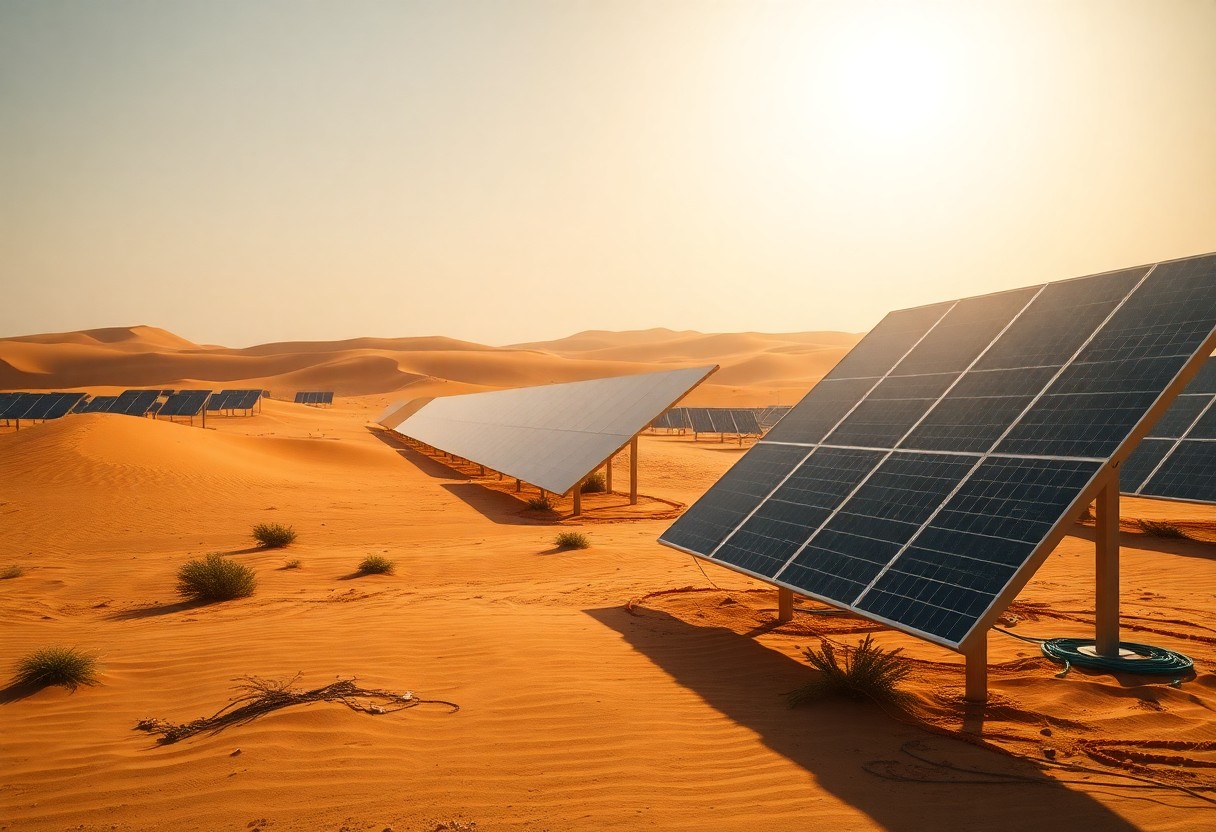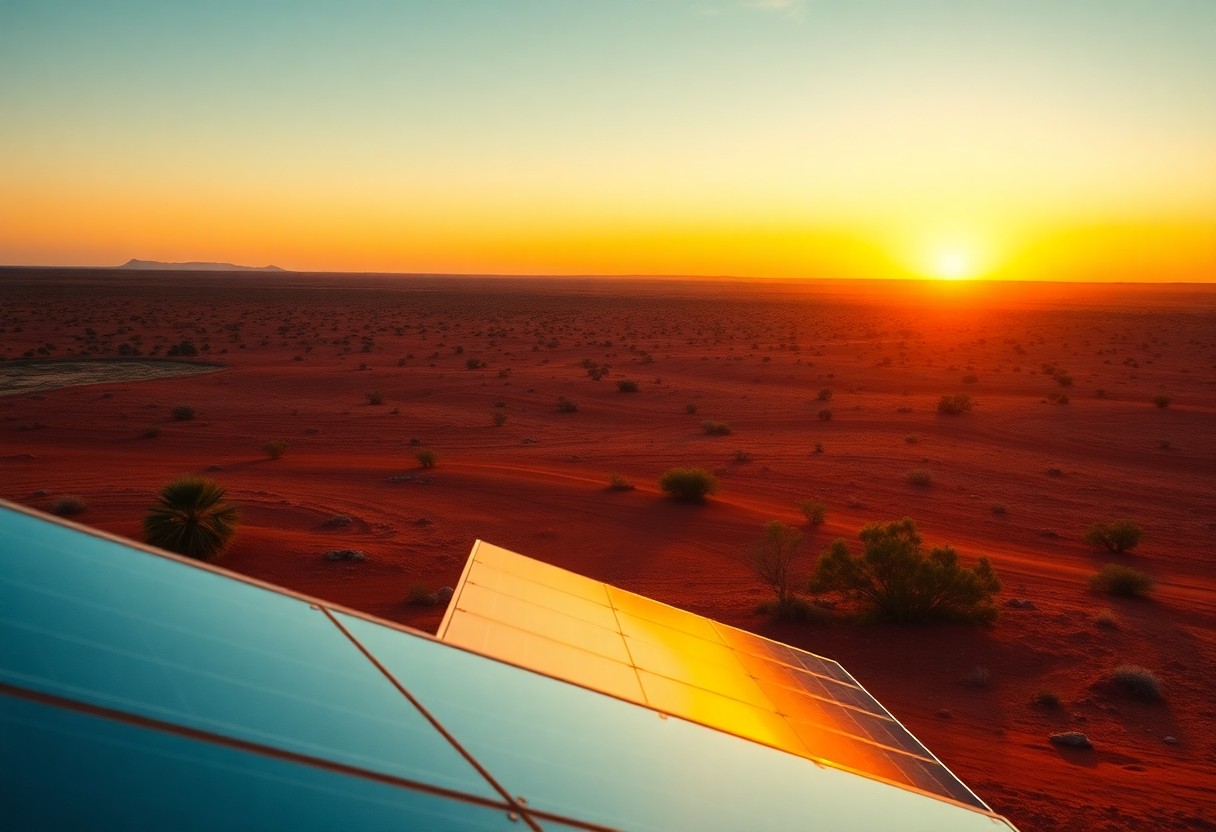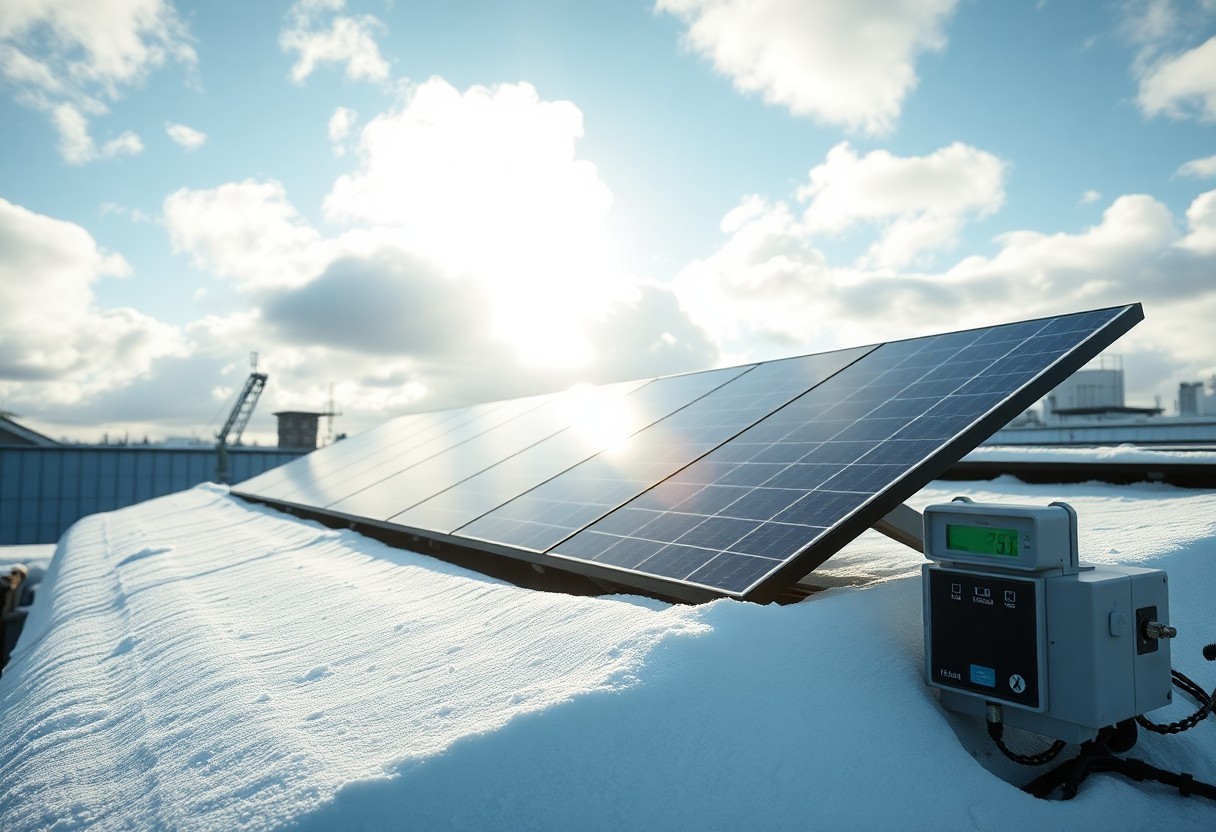Solar energy has the potential to unlock a world of possibilities for you in the Sahara Desert. With the region’s abundant sunlight, solar power can provide sustainable energy solutions that address critical challenges such as water scarcity and limited access to electricity. By harnessing this renewable resource, you can greatly improve your quality of life, enhance local economies, and promote environmental sustainability. Discover how embracing solar technology can lead to transformative changes for you and future generations living in this arid landscape.
Key Takeaways:
- Solar power can provide sustainable energy solutions for remote communities in the Sahara Desert, improving living standards and enabling access to crucial services like healthcare and education.
- Utilizing solar energy can help combat climate change by reducing reliance on fossil fuels, promoting environmental sustainability in one of the world’s most vulnerable ecosystems.
- The abundance of sunlight in the Sahara presents significant opportunities for solar energy development, potentially turning the region into a renewable energy hub that could supply energy to nearby areas.
The Potential of Solar Energy in the Sahara
Your exploration of solar energy reveals an immense potential for transformation in the Sahara Desert. This region, often seen as barren and inhospitable, actually holds a wealth of opportunities through harnessing solar power. With vast expanses of land exposed to sunlight, the Sahara can become a hub for renewable energy production, significantly enhancing the lives of its inhabitants while contributing to global sustainability efforts.
Abundant Sunlight Availability
Beside the vast desert landscapes, the Sahara boasts some of the highest solar irradiation levels on the planet. This abundant sunlight provides a natural resource for generating clean energy, offering a sustainable solution to meet the local energy needs and potentially exporting it beyond its borders.
Technological Advancements in Solar Power
For those looking to capitalize on solar energy, new technological advancements present exciting possibilities. Innovations such as solar panels with improved efficiency and energy storage systems are transforming how solar power can be utilized, making it not only feasible but also reliable for long-term energy solutions.
Advancements in solar technology are profoundly enhancing the efficiency and accessibility of solar power. With developments in photovoltaic cell technology, solar panels are now capable of converting even more sunlight into energy. Furthermore, emerging energy storage solutions, such as advanced batteries, allow for excess energy to be saved for later use, ensuring a consistent power supply regardless of weather conditions. These innovations position solar power not only as a viable energy source but also as a potent means to foster economic growth and improve living conditions in the Sahara Desert.
Impact on Local Communities
It is undeniable that solar power can radically enhance the lives of local communities in the Sahara Desert. By providing a sustainable source of energy, it can help improve living conditions, reduce reliance on fossil fuels, and facilitate economic growth. Solar energy can empower residents by creating job opportunities, increasing food production, and improving access to vital services such as clean water and electricity.
Energy Access and Economic Development
Any community that gains access to solar power can experience significant economic development. By generating renewable energy locally, residents can save on energy costs, stimulate local businesses, and attract investments. This can lead to job creation in various sectors, empowering families to thrive economically and creating a more robust and resilient community.
Education and Healthcare Improvements
Improvements in education and healthcare can also be achieved through solar power in the Sahara Desert. Solar energy can provide electricity to remote schools and health clinics, enabling the use of vital technologies and resources. This means that students can benefit from computer access and online learning, while healthcare facilities can store medications safely and offer more reliable services. Enhanced educational and healthcare opportunities can lead to a better-informed population, ultimately improving quality of life for all.
Considering the importance of these advancements, implementing solar power can significantly improve access to quality education and healthcare. Schools powered by solar energy can offer better facilities, learning materials, and extracurricular activities, while healthcare centers can operate with vital medical equipment for diagnostics and treatment. In areas where accessing doctor’s offices and pharmacies can be dangerous or challenging, reliable solar energy can help establish a consistent healthcare presence. Enhancing educational and healthcare systems through solar power not only transforms immediate living conditions but fosters long-term growth and resilience for future generations.
Environmental Benefits
For the Sahara Desert, harnessing solar power brings remarkable environmental benefits. This technology can effectively combat the harsh climate and promote sustainability. By utilizing renewable energy, you can mitigate the impact of fossil fuels, leading to healthier air quality and a more stable ecosystem. Moreover, solar installations can help preserve the natural habitat and biodiversity endemic to the desert, fostering a more balanced environment for generations to come.
Reducing Carbon Footprint
Reducing your carbon footprint is crucial in combating climate change. By adopting solar power, you significantly decrease reliance on traditional energy sources that produce harmful emissions. This transition leads to cleaner air and a healthier planet, allowing you to take part in the global movement toward sustainability.
Promoting Sustainable Practices
Environmental awareness in the Sahara can lead to the promotion of sustainable practices that benefit both communities and ecosystems. For instance, solar energy can empower local farmers to adopt innovative agricultural techniques. By utilizing solar-powered irrigation systems, you can minimize water wastage and enhance crop yields while relying on clean energy. Moreover, supporting solar technology encourages employment opportunities in green sectors, ultimately leading to a more resilient economy. Transitioning to solar power fosters a culture of sustainability that integrates renewable energy into everyday life, benefiting both people and the environment.

Challenges and Considerations
Unlike many regions, implementing solar power in the Sahara Desert presents unique challenges. Factors such as extreme weather conditions, logistical difficulties in transporting materials, and limited access to financing can hinder progress. Ensuring sustainable and efficient energy solutions for remote communities requires not only innovative technology but also careful planning to tackle these obstacles effectively.
Infrastructure Development
Any viable solar power project in the Sahara requires significant infrastructure development. This includes constructing solar farms, developing grid systems to distribute the energy, and establishing transportation networks to facilitate maintenance. Addressing these needs is necessary to maximize the potential of solar energy and ensure it reaches those in need.
Political and Economic Stability
Against the backdrop of the Sahara’s potential, political and economic stability plays a critical role in solar power success. Without stable governance, investments in solar infrastructure may falter, leaving communities deprived of reliable energy sources.
Indeed, achieving political and economic stability is vital for realizing your solar power aspirations in the Sahara. Governments must foster a conducive environment for investment through transparent policies and collaboration with international partners. Furthermore, addressing local needs will encourage grassroots support for projects, making them more sustainable in the long run. A robust framework for governance can lead to economic growth, enhancing job opportunities and improving the quality of life for communities. By ensuring stability, you can unlock the transformative potential of solar energy.
Global Energy Market Implications
Once again, the rise of solar power has the potential to reshape the global energy market. As nations shift towards sustainable solutions, the Sahara Desert’s vast solar potential offers a significant opportunity to reduce dependence on fossil fuels. By harnessing this renewable resource, you can contribute to diversifying energy supply and stabilizing prices, ultimately leading to enhanced energy security and economic partnerships worldwide.
Solar Power as a Renewable Resource
Between the endless sunlight and the expanding technology for solar energy, the Sahara Desert stands as an unmatched repository of renewable resources. You can tap into this seemingly infinite energy source to fuel local economies, drive development, and decrease carbon emissions, ensuring a more sustainable future for generations to come.
Exporting Solar Energy to Europe and Beyond
Europe stands to gain immensely from the Sahara Desert’s solar energy potential. By investing in infrastructure, you could facilitate the transfer of solar power across continents, addressing energy shortages and reinforcing sustainability efforts in your region.
Due to the strategic location of the Sahara Desert, there is a significant opportunity for exporting solar energy to Europe and beyond. With the development of high-voltage direct-current (HVDC) technology, you can efficiently transmit electricity over long distances, making it feasible to send vast amounts of renewable power to European markets. This initiative could drastically reduce carbon footprints while enhancing energy independence. Furthermore, by establishing a collaborative framework with European nations, you can create jobs and bolster economic growth in the Sahara while addressing energy demands across continents. The positive implications of this venture are enormous, paving the way for a cleaner, more sustainable global energy landscape.
Future Prospects for Solar Power in the Sahara
After establishing a robust solar infrastructure, the Sahara holds immense potential for generating clean energy. As technology advances, your capacity to harness solar power could expand, leading to transformative shifts in energy production and local economies. With significant investment and international collaboration, you can expect a landscape where renewable energy not only powers communities but also supports a sustainable future for generations to come.
Investment Opportunities
Any investor looking for promising avenues should consider the Sahara as a prime location for solar energy projects. The region’s vast, sun-drenched expanses present exceptional opportunities for developing large-scale solar farms. With government incentives and a growing global focus on sustainability, your investment could reap substantial long-term benefits.
Innovations on the Horizon
Around the world, innovative technologies are emerging that promise to enhance solar energy efficiency and storage capabilities. These advancements, like perovskite solar cells and advanced energy storage solutions, can dramatically improve your ability to harness solar power in the Sahara. They offer the potential for higher energy yield and make solar solutions more accessible to remote communities.
Future innovations are expected to revolutionize solar energy access in the Sahara. Notable advancements include the development of bifacial solar panels that capture sunlight from both sides, significantly increasing output. Moreover, breakthroughs in energy storage technologies, such as next-generation batteries, will enable you to store solar energy for nighttime use or during periods of low sunlight. As these technologies mature, they’ll create an energy landscape that is not only more efficient but also more reliable and sustainable for your community’s future.
Summing up
With this in mind, you can see how solar power has the potential to dramatically improve life in the Sahara Desert. By harnessing abundant sunlight, you can provide clean energy for homes, schools, and businesses, fostering economic development and improving health services. Additionally, solar technology offers innovative solutions for water purification and irrigation, enabling sustainable agriculture. As you explore these possibilities, you’ll realize that solar power not only transforms energy access but also empowers communities to thrive in one of the world’s most challenging environments.
Q: How can solar power improve access to clean water in the Sahara Desert?
A: Solar power can significantly enhance access to clean water in the Sahara through solar-powered desalination and water purification systems. By harnessing the abundant sunlight in the region, these systems can convert seawater into potable water or remove contaminants from existing water sources. This technology allows remote communities to access reliable water supply, reducing dependency on traditional water sources that may be scarce or contaminated, leading to better health outcomes and increased agricultural productivity.
Q: In what ways can solar energy contribute to economic development in the Sahara?
A: Solar energy can drive economic development in the Sahara by creating job opportunities and reducing energy costs. With the establishment of solar farms and the promotion of solar technologies, locals can find work in various sectors such as manufacturing, installation, and maintenance. Additionally, solar power can provide affordable electricity for businesses, encouraging entrepreneurship and innovation. Access to reliable energy can also enhance productivity in agriculture and tourism, ultimately stimulating economic growth across the region.
Q: How can solar power aid in education and technology access in the Sahara Desert?
A: Solar power can significantly enhance education and technology access in the Sahara by providing the necessary electricity for schools and community centers. With solar energy, educational institutions can operate computers, internet access, and other electronic tools crucial for modern learning. This access to technology not only enriches the educational experience but also allows students to connect with the global community, fostering crucial skills for the digital age. Furthermore, off-grid solar solutions can enable nighttime study and provide resources for digital learning, promoting lifelong learning opportunities in remote areas.


